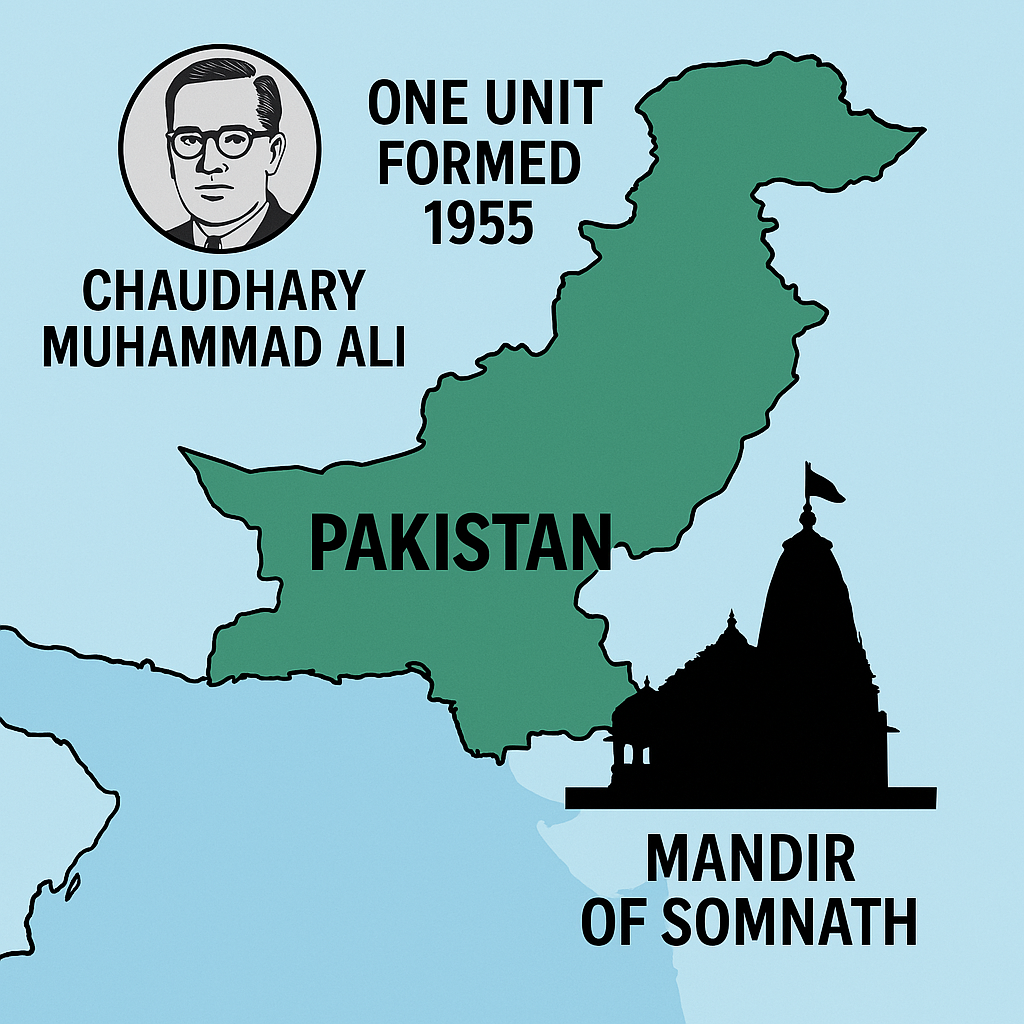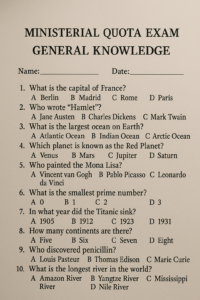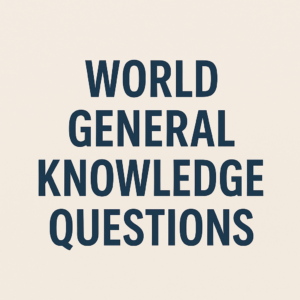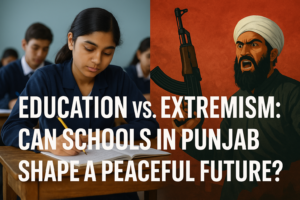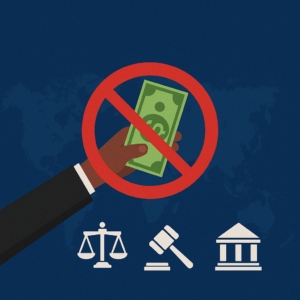The Salt Range
- Explanation: The Salt Range is a famous mountain range in Pakistan, known for its rich deposits of rock salt.
- Q: Which country is the largest producer of cotton?
A: (C) China
Explanation: China is the world’s largest producer of cotton, contributing significantly to the global textile industry. - Q: The Indus Water Treaty was signed between which two countries?
A: (B) India and Pakistan
Explanation: The Indus Water Treaty, signed in 1960, governs water sharing between India and Pakistan, mediated by the World Bank. - Q: Who was the first Muslim Governor-General of Pakistan?
A: (C) Muhammad Ali Jinnah
Explanation: Muhammad Ali Jinnah was Pakistan’s first Governor-General after independence in 1947. - Q: What is the capital of Canada?
A: (B) Ottawa
Explanation: Ottawa is the capital of Canada, serving as the political and administrative center of the country. - Q: The chemical formula of water is?
A: (A) H₂O
Explanation: Water is composed of two hydrogen atoms and one oxygen atom, hence the formula H₂O. - Q: What is the national flower of Pakistan?
A: (C) Jasmine
Explanation: Jasmine (Chameli) is Pakistan’s national flower due to its fragrance and cultural significance. - Q: Which vitamin is essential for blood clotting?
A: (B) Vitamin K
Explanation: Vitamin K plays a crucial role in blood clotting and preventing excessive bleeding. - Q: What is the currency of Japan?
A: (D) Yen
Explanation: The Japanese Yen (¥) is the official currency of Japan and one of the most traded currencies worldwide. - Q: Who wrote the famous book “Gulliver’s Travels”?
A: (A) Jonathan Swift
Explanation: “Gulliver’s Travels,” written by Jonathan Swift, is a famous satirical novel published in 1726. - Q: The headquarters of the United Nations is located in?
A: (B) New York, USA
Explanation: The UN headquarters is in New York City, serving as the center for international diplomacy and peacekeeping efforts. - Q: What is the smallest planet in our solar system?
A: (C) Mercury
Explanation: Mercury is the smallest and closest planet to the Sun, with extreme temperature variations. - Q: The Great Wall of China was built for what purpose?
A: (A) Defense
Explanation: The Great Wall of China was constructed primarily to protect against invasions from northern tribes. - Q: What is the capital of Australia?
A: (D) Canberra
Explanation: Canberra was chosen as Australia’s capital to resolve rivalry between Sydney and Melbourne. - Q: The Suez Canal connects which two bodies of water?
A: (B) Mediterranean Sea and Red Sea
Explanation: The Suez Canal is a vital waterway linking the Mediterranean and Red Seas, reducing travel time between Europe and Asia. - Q: What is the chemical symbol for gold?
A: (A) Au
Explanation: The symbol “Au” comes from the Latin word “Aurum,” meaning gold. - Q: Which country is known as the Land of the Rising Sun?
A: (C) Japan
Explanation: Japan is called the Land of the Rising Sun because it is located to the east, where the sun rises first. - Q: The largest ocean on Earth is?
A: (B) Pacific Ocean
Explanation: The Pacific Ocean is the largest and deepest ocean, covering more than 30% of the Earth’s surface. - Q: Who discovered gravity?
A: (D) Isaac Newton
Explanation: Sir Isaac Newton discovered gravity when he observed an apple falling from a tree, leading to the formulation of the laws of motion. - Q: The Eiffel Tower is located in which city?
A: (A) Paris
Explanation: The Eiffel Tower, one of the world’s most famous landmarks, is located in Paris, France. - Q: What is the national animal of Pakistan?
A: (B) Markhor
Explanation: The Markhor, a wild goat species, is Pakistan’s national animal, symbolizing resilience and strength. - Q: What is the chemical formula for table salt?
A: (C) NaCl
Explanation: Table salt is composed of sodium (Na) and chloride (Cl), forming sodium chloride (NaCl). - Q: Which planet is known as the Red Planet?
A: (A) Mars
Explanation: Mars is called the Red Planet due to its reddish appearance caused by iron oxide on its surface. - Q: What is the hardest natural substance on Earth?
A: (D) Diamond
Explanation: Diamond is the hardest naturally occurring substance, widely used in cutting and drilling tools. - Q: Who invented the telephone?
A: (B) Alexander Graham Bell
Explanation: Alexander Graham Bell invented the telephone in 1876, revolutionizing communication. - Q: Which river is the longest in the world?
A: (C) Nile River
Explanation: The Nile River, stretching about 6,650 km, is the longest river, flowing through northeastern Africa. - Q: What is the national game of Pakistan?
A: (B) Field Hockey
Explanation: Field hockey is Pakistan’s national sport, and the country has won multiple world championships in it. - Q: Who was the first President of the United States?
A: (A) George Washington
Explanation: George Washington served as the first President of the USA from 1789 to 1797. - Q: Which gas do plants absorb from the atmosphere?
A: (C) Carbon Dioxide
Explanation: Plants absorb carbon dioxide (CO₂) during photosynthesis to produce oxygen and glucose. - Q: The currency of the United Kingdom is?
A: (D) Pound Sterling
Explanation: The official currency of the United Kingdom is the Pound Sterling (£). - Q: The Great Barrier Reef is located in which country?
A: (A) Australia
Explanation: The Great Barrier Reef, the world’s largest coral reef system, is located off the coast of Australia. - Q: What is the largest desert in the world?
A: (B) Antarctica Desert
Explanation: The Antarctic Desert is the world’s largest desert, covering about 14 million square kilometers. - Q: Who was the first woman Prime Minister of Pakistan?
A: (C) Benazir Bhutto
Explanation: Benazir Bhutto became the first female Prime Minister of Pakistan in 1988. - Q: What is the smallest bone in the human body?
A: (D) Stapes
Explanation: The stapes, located in the middle ear, is the smallest bone in the human body. - Q: Which continent has the most countries?
A: (A) Africa
Explanation: Africa has 54 recognized sovereign nations, the highest of any continent. - Q: Who wrote the national anthem of Pakistan?
A: (B) Hafeez Jalandhari
Explanation: Hafeez Jalandhari wrote the lyrics of Pakistan’s national anthem in 1952.- Adoption Date: Officially adopted on 13 August 1954.
- Composer: Music composed by Ahmad G. Chagla in 1949.
- Lyricist: Written by Hafeez Jalandhari in 1952.
- First Official Broadcast: Aired on Radio Pakistan in 1955.
- Language: Written in Persian and Arabic vocabulary.
- Duration: The anthem is 80 seconds long.
- Number of Stanzas: Comprises three stanzas.
- Number of Words: Contains 38 words in total.
- Number of Singers in First Recording: 11 singers, including Noor Jehan and Ahmed Rushdi.
- Music Approval: The music was approved by the government in 1950.
- Competition for Lyrics: Held in 1952, where Hafeez Jalandhari’s lyrics were selected.
- Original Temporary Anthem: “Tarana-e-Pakistan” by Jagannath Azad was used before the official anthem.
- Unique Fact: One of the shortest yet most melodious national anthems in the world.
- Theme: Represents Islamic values, national unity, and patriotism.
- First Anthem Recording Location: Recorded in Radio Pakistan’s Karachi studio.
- Q: The ozone layer is found in which layer of the atmosphere?
A: (C) Stratosphere (12 to 50 km).
Explanation: The ozone layer, which protects Earth from harmful UV rays, is located in the stratosphere. - Q: Which is the most abundant gas in the Earth’s atmosphere?
A: (A) Nitrogen
Explanation: Nitrogen makes up about 78% of the Earth’s atmosphere. - Q: The Battle of Panipat (1526) was fought between?
A: (B) Babur and Ibrahim Lodi
Explanation: The first Battle of Panipat in 1526 led to the establishment of the Mughal Empire in India. - Q: The study of earthquakes is called?
A: (D) Seismology
Explanation: Seismology is the scientific study of earthquakes and seismic waves. - Q: Who was the founder of the All India Muslim League?
A: (C) Nawab Salimullah Khan
Explanation: The All India Muslim League was founded on 30 December 1906 under the leadership of Nawab Salimullah Khan of Dhaka. - Q: The world’s tallest mountain is?
A: (A) Mount Everest
Explanation: Mount Everest, located in the Himalayas, is the tallest mountain at 8,848.86 meters above sea level. - Q: The first Nobel Prize in Physics was awarded to?
A: (B) Wilhelm Roentgen
Explanation: Wilhelm Roentgen won the first Physics Nobel Prize in 1901 for discovering X-rays. - Born: Alfred Nobel was born on 21 October 1833 in Stockholm, Sweden.
- Invention: He invented dynamite in 1867, revolutionizing construction and warfare.
- Nobel Prize: He established the Nobel Prizes in his will, first awarded in 1901.
- Dynamite is used in construction, mining, quarrying, and military applications for controlled explosions.
- The chemical formula of Surma (Kohl) varies depending on its composition. Traditional Surma often contains Galena (Lead Sulfide), which has the chemical formula: PbS (Lead Sulfide)However, some modern or herbal Surma may be lead-free and contain carbon-based compounds like antimony sulfide (Sb₂S₃) or other natural ingredients.
- Q: What is the hardest naturally occurring metal?
A: (C) Tungsten
Explanation: Tungsten is the hardest natural metal with the highest melting point among all metals. - Cesium (Cs) is the softest metal, with a Mohs hardness of 0.2 and a low melting point of 28.5°C. It can even be cut with knife.
- Q: Who built the Taj Mahal?
A: (D) Shah Jahan
Explanation: The Mughal Emperor Shah Jahan built the Taj Mahal in memory of his wife Mumtaz Mahal. - Q: The Grand Trunk Road was built by?
A: (A) Sher Shah Suri
Explanation: Sher Shah Suri constructed the Grand Trunk Road, one of South Asia’s oldest and longest roads. - Q: What is the boiling point of water at sea level?
A: (B) 100°C
Explanation: Water boils at 100 degrees Celsius (212°F) at standard atmospheric pressure. - Q: Who was the first Muslim to win a Nobel Prize?
A: (C) Dr. Abdus Salam
Explanation: Dr. Abdus Salam, a Pakistani physicist, won the Nobel Prize in Physics in 1979 for his contribution to electroweak theory. - Q: The atomic bomb was dropped on Hiroshima in which year?
A: (B) 1945
Explanation: The United States dropped an atomic bomb on Hiroshima on August 6, 1945, during World War II. - World War II (1939-1945) was fought between the Allied Powers (including the USA, USSR, UK, China, and France) and the Axis Powers (Germany, Italy, and Japan).
- World War I (1914-1918) was fought between the Allied Powers (mainly France, the United Kingdom, Russia, and later the United States) and the Central Powers (mainly Germany, Austria-Hungary, the Ottoman Empire, and Bulgaria).
- Pearl Harbor was a surprise attack by Japan against the US naval base in Hawaii on 7 December 1941, leading to the United States’ entry into World War II.
- Q: The currency of Saudi Arabia is?
A: (D) Riyal
Explanation: The official currency of Saudi Arabia is the Saudi Riyal (SAR). - Q: The deepest part of the ocean is?
A: (A) Mariana Trench
Explanation: The Mariana Trench, located in the Pacific Ocean, is the deepest oceanic trench in the world, reaching about 11,000 meters. - Q: What is the longest river in Pakistan?
A: (B) Indus River
Explanation: The Indus River is Pakistan’s longest river, flowing about 3,180 km from Tibet to the Arabian Sea. - Q: Who was the first Caliph of Islam?
A: (A) Hazrat Abu Bakr (RA)
Explanation: Hazrat Abu Bakr (RA) became the first Caliph after the passing of Prophet Muhammad (PBUH) in 632 AD. - Q: What is the national bird of Pakistan?
A: (C) Chukar Partridge
Explanation: The Chukar Partridge is Pakistan’s national bird, often associated with passion and determination. - Q: The Mona Lisa painting was created by?
A: (D) Leonardo da Vinci
Explanation: Leonardo da Vinci painted the Mona Lisa in the 16th century, making it one of the most famous artworks in history. - Q: Which gas is essential for human respiration?
A: (B) Oxygen
Explanation: Oxygen is necessary for respiration, allowing humans and animals to produce energy. - Q: The Olympic Games originated in which country?
A: (A) Greece
Explanation: The ancient Olympic Games were first held in Olympia, Greece, in 776 BC. - Q: The currency of China is?
A: (C) Yuan (Renminbi)
Explanation: The official currency of China is the Renminbi (RMB), commonly called the Yuan. - Q: The largest gland in the human body is?
A: (B) Liver
Explanation: The liver is the largest gland in the human body, performing functions like detoxification and digestion. - Q: What is the study of plants called?
A: (D) Botany
Explanation: Botany is the scientific study of plants, including their structure, growth, and diseases. - Q: The smallest country in the world by area is?
A: (A) Vatican City
Explanation: Vatican City is the smallest independent country, covering only 0.49 square kilometers. - Q: The deepest lake in the world is?
A: (B) Lake Baikal
Explanation: Lake Baikal in Russia is the deepest freshwater lake, reaching a depth of about 1,642 meters. - Q: Who discovered Penicillin?
A: (C) Alexander Fleming
Explanation: Alexander Fleming discovered Penicillin in 1928, leading to the development of antibiotics. - Q: The longest-serving Prime Minister of Pakistan was?
A: (D) Liaquat Ali Khan
Explanation: Liaquat Ali Khan served as Pakistan’s first and longest-serving Prime Minister from 1947 to 1951. - Q: What is the capital of South Korea?
A: (A) Seoul
Explanation: Seoul is the capital and largest city of South Korea, known for its technological advancements. - In 2025, Han Duck-soo is serving as the acting president of South Korea following the impeachment of Yoon Suk Yeol. Declared martial Law in 2024).
- Q: The Panama Canal connects which two oceans?
A: (B) Atlantic and Pacific Oceans
Explanation: The Panama Canal is a crucial waterway linking the Atlantic and Pacific Oceans, reducing maritime travel time. - Q: Who wrote “Romeo and Juliet”?
A: (C) William Shakespeare
Explanation: “Romeo and Juliet” is a tragic play written by William Shakespeare in the late 16th century. - Q: What is the speed of light in a vacuum?
A: (D) 299,792 km/s
Explanation: Light travels at approximately 299,792 kilometers per second in a vacuum. - Q: Who is known as the “Father of Computers”?
A: (A) Charles Babbage
Explanation: Charles Babbage is credited with designing the first mechanical computer in the 19th century. - Q: The first artificial satellite, Sputnik 1, was launched by?
A: (B) Soviet Union
Explanation: The Soviet Union launched Sputnik 1 on October 4, 1957, marking the beginning of the space age. - Q: What is the capital of Turkey?
A: (C) Ankara
Explanation: Although Istanbul is Turkey’s largest city, Ankara is its capital and political center. - Q: Which gas is commonly used in balloons?
A: (D) Helium
Explanation: Helium is lighter than air and non-flammable, making it ideal for inflating balloons. - Q: The Nobel Peace Prize is awarded in which city?
A: (A) Oslo, Norway
Explanation: The Nobel Peace Prize is awarded annually in Oslo, while other Nobel Prizes are awarded in Stockholm, Sweden. - Q: The longest highway in the world is?
A: Pan American Highway.
Explanation: The Pan-American Highway extends about 30,000 km from North America to South America. - Q: Who discovered America in 1492?
A: (C) Christopher Columbus
Explanation: Christopher Columbus, an Italian explorer, reached the Americas in 1492 while searching for a new trade route to India. - Q: What is the unit of electrical resistance?
A: (D) Ohm
Explanation: The unit of electrical resistance is the ohm (Ω), named after the German physicist George Simon Ohm. - Q: Which city is known as the “City of Canals”?
A: (B) Venice
Explanation: Venice, Italy, is famous for its canals, which serve as roads for transportation. - Q: What is the chemical symbol for silver?
A: (C) Ag
Explanation: Silver’s symbol “Ag” is derived from its Latin name, “Argentum.” - Q: The Titanic sank in which year?
A: (D) 1912
Explanation: The Titanic sank on April 15, 1912, after hitting an iceberg in the North Atlantic Ocean. - Q: Which organ in the human body produces insulin?
A: (A) Pancreas
Explanation: The pancreas produces insulin, which regulates blood sugar levels. - Q: The world’s largest island is?
A: (B) Greenland
Explanation: Greenland is the largest island in the world, covering over 2.16 million square kilometers. - Q: The study of stars and space is called?
A: (D) Astronomy
Explanation: Astronomy is the scientific study of celestial bodies, space, and the universe. - Q: What is the capital of Canada?
A: (C) Ottawa
Explanation: Ottawa is the capital of Canada, although Toronto is its largest city. - Q: The first man to walk on the moon was?
A: (A) Neil Armstrong
Explanation: Neil Armstrong became the first person to walk on the moon on July 20, 1969, during the Apollo 11 mission. - Q: The currency of Brazil is?
A: (B) Real
Explanation: The official currency of Brazil is the Brazilian Real (BRL). - Q: What is the pH value of pure water?
A: (C) 7
Explanation: Pure water has a neutral pH of 7, meaning it is neither acidic nor basic. - Q: The Berlin Wall fell in which year?
A: (D) 1989
Explanation: The Berlin Wall, which separated East and West Germany, was torn down on November 9, 1989. - Q: The atomic number of oxygen is?
A: (A) 8
Explanation: Oxygen has an atomic number of 8, meaning it has eight protons in its nucleus. - Q: Who was the first female Prime Minister in the world?
A: (B) Sirimavo Bandaranaike
Explanation: Sirimavo Bandaranaike of Sri Lanka became the world’s first female Prime Minister in 1960. - Q: The largest mammal in the world is?
A: (C) Blue Whale
Explanation: The blue whale is the largest living mammal, growing up to 100 feet long. - Q: The currency of the European Union is?
A: (D) Euro
Explanation: The Euro (€) is the official currency of 20 European Union countries. - Q: Which planet is known as the “Morning Star”?
A: (A) Venus
Explanation: Venus is called the “Morning Star” and “Evening Star” because it is visible at dawn and dusk. - Q: The Great Fire of London occurred in which year?
A: (B) 1666
Explanation: The Great Fire of London started on September 2, 1666, and lasted for four days. - Q: The second-largest continent in the world is?
A: (C) Africa
Explanation: Africa is the second-largest continent after Asia, covering about 30 million square kilometers. - Q: The chemical formula for water is?
A: (D) H₂O
Explanation: Water consists of two hydrogen (H) atoms and one oxygen (O) atom, forming H₂O. - Q: Who painted the “Starry Night“?
A: (A) Vincent van Gogh
Explanation: Vincent van Gogh painted “Starry Night” in 1889, depicting a swirling night sky. - Q: Which desert is the driest in the world?
A: (B) Atacama Desert
Explanation: The Atacama Desert in Chile is the driest non-polar desert, receiving little to no rainfall. - Q: The International Court of Justice is located in?
A: (C) The Hague, Netherlands
Explanation: The International Court of Justice (ICJ) is the main judicial body of the United Nations. - Q: The hardest natural mineral on Earth is?
A: (D) Diamond
Explanation: Diamond is the hardest known natural material, often used in cutting and drilling tools. - Q: The largest democracy in the world is?
A: (A) India
Explanation: India is the world’s largest democracy, with over 900 million eligible voters. - Q: Who developed the theory of relativity?
A: (B) Albert Einstein
Explanation: Albert Einstein proposed the theory of relativity, including the famous equation E=mc². - Q: What is the largest ocean in the world?
A: (B) Pacific Ocean
Explanation: The Pacific Ocean covers about 63 million square miles, making it the largest ocean on Earth. - Q: Who discovered gravity?
A: (A) Isaac Newton
Explanation: Sir Isaac Newton formulated the law of universal gravitation in the 17th century. - Q: What is the capital of Australia?
A: (C) Canberra
Explanation: Canberra was chosen as Australia’s capital to settle the rivalry between Sydney and Melbourne. - Q: The Statue of Liberty was a gift from which country?
A: (D) France
Explanation: France gifted the Statue of Liberty to the United States in 1886 as a symbol of friendship. - Q: The Great Wall of China was built to protect against invasions from?
A: (B) Mongols
Explanation: The Great Wall was built to defend against Mongol invasions from the north. - Q: What is the longest river in the world?
A: (A) Nile River
Explanation: The Nile River is the world’s longest, stretching about 6,650 km through northeastern Africa. - Q: Who was the first President of the United States?
A: (C) George Washington
Explanation: George Washington served as the first U.S. President from 1789 to 1797. - Q: What is the hardest naturally occurring substance?
A: (D) Diamond
Explanation: Diamond is the hardest natural material, ranking highest on the Mohs hardness scale. - Q: The Eiffel Tower is located in which city?
A: (A) Paris
Explanation: The Eiffel Tower, completed in 1889, is a famous landmark in Paris, France. - Q: Who is known as the “Father of Pakistan”?
A: (B) Quaid-e-Azam Muhammad Ali Jinnah
Explanation: Muhammad Ali Jinnah led the creation of Pakistan in 1947 and served as its first Governor-General. - Q: The longest-serving ruler in world history was?
A: (C) King Louis XIV
Explanation: King Louis XIV of France ruled for 72 years (1643–1715), making him the longest-reigning monarch. - Q: The term “Cold War” refers to tensions between which two nations?
A: (D) USA and USSR
Explanation: The Cold War (1947–1991) was a period of political and military tension between the USA and the Soviet Union. - Q: The speed of sound is fastest in?
A: (B) Solids
Explanation: Sound travels fastest in solids due to their high density and strong intermolecular bonds. - Q: Who is credited with inventing the telephone?
A: (C) Alexander Graham Bell
Explanation: Alexander Graham Bell invented the telephone in 1876, revolutionizing communication. - Q: The world’s largest coral reef system is?
A: (D) Great Barrier Reef
Explanation: The Great Barrier Reef, located in Australia, is the largest coral reef system on Earth. - Q: The national flower of Pakistan is?
A: (A) Jasmine
Explanation: Jasmine (Chambeli) is Pakistan’s national flower, symbolizing purity and simplicity. - Q: Which country is known as the Land of the Rising Sun?
A: (B) Japan
Explanation: Japan is called the Land of the Rising Sun because it is one of the first countries to see sunrise each day. - Q: What is the process of converting water into vapor called?
A: (C) Evaporation
Explanation: Evaporation is the process where water turns into vapor due to heat. - Q: The largest producer of oil in the world is?
A: (D) USA
Explanation: The United States is the world’s largest producer of crude oil, followed by Saudi Arabia and Russia. - The largest producer of oil in the world is the United States. As of recent data, the U.S. has surpassed Saudi Arabia and Russia in oil production, primarily due to the boom in shale oil production. The country produces millions of barrels of oil per day, making it the top oil producer globally.
- Q: The Nobel Prizes were founded by?
A: (A) Alfred Nobel
Explanation: Alfred Nobel, a Swedish chemist and inventor of dynamite, established the Nobel Prizes in his will. - Q: Which animal is known as the “Ship of the Desert”?
A: (B) Camel
Explanation: The camel is called the Ship of the Desert because it can travel long distances without water. - Q: The Big Bang Theory explains?
A: (C) The origin of the universe
Explanation: The Big Bang Theory suggests that the universe began with a massive explosion around 13.8 billion years ago. - Q: The shortest day of the year occurs on?
A: (D) December 21
Explanation: The winter solstice on December 21 is the shortest day of the year in the Northern Hemisphere. - Q: What is the chemical name of common salt?
A: (A) Sodium chloride
Explanation: Table salt is scientifically known as sodium chloride (NaCl). - Q: The national animal of Pakistan is?
A: (B) Markhor
Explanation: The Markhor, a wild goat species, is Pakistan’s national animal. - Q: What is the capital of Russia?
A: (B) Moscow
Explanation: Moscow is the capital and the largest city of Russia, serving as its political and economic hub. - Q: Who wrote the play Romeo and Juliet?
A: (A) William Shakespeare
Explanation: William Shakespeare wrote Romeo and Juliet, a famous tragedy about two star-crossed lovers. - Q: What is the hardest natural substance on Earth?
A: (C) Diamond
Explanation: Diamond ranks highest on the Mohs hardness scale, making it the hardest naturally occurring material. - Q: What is the national bird of Pakistan?
A: (D) Chukar Partridge
Explanation: The Chukar Partridge is Pakistan’s national bird, known for its resilience and beauty. - Q: The world’s smallest continent is?
A: (B) Australia
Explanation: Australia is both a country and the smallest continent, covering about 8.6 million square kilometers. - Q: Who painted the Mona Lisa?
A: (A) Leonardo da Vinci
Explanation: The Mona Lisa is a famous portrait painted by Leonardo da Vinci in the early 16th century. - Q: The chemical symbol for gold is?
A: (C) Au
Explanation: Gold’s symbol “Au” is derived from its Latin name, “Aurum.” - Q: What is the currency of Japan?
A: (D) Yen
Explanation: The Japanese Yen (¥) is the official currency of Japan. - Q: The largest desert in the world is?
A: (A) Antarctic Desert
Explanation: The Antarctic Desert is the largest desert, covering around 14 million square kilometers. - Q: Who was the first woman to win a Nobel Prize?
A: (B) Marie Curie
Explanation: Marie Curie won the Nobel Prize in Physics in 1903 and later in Chemistry in 1911. - Q: The SI unit of force is?
A: (C) Newton
Explanation: Force is measured in Newtons (N), named after Sir Isaac Newton. - Q: Which is the longest mountain range in the world?
A: (D) Andes
Explanation: The Andes mountain range stretches across seven South American countries. - Q: The human body has how many bones?
A: (A) 206
Explanation: An adult human has 206 bones, while a newborn has about 270, which later fuse together. - A newborn baby typically has 270 bones at birth. Over time, as the child grows, some of these bones fuse together, and by the time they reach adulthood, the number of bones decreases to 206.
- Human body has 12 pairs of cranial nerves.
- Q: The Great Pyramid of Giza was built for which pharaoh?
A: (B) Khufu
Explanation: Pharaoh Khufu (Cheops) commissioned the Great Pyramid around 2600 BC. - Q: The largest freshwater lake by surface area is?
A: (C) Lake Superior
Explanation: Lake Superior, located in North America, is the largest freshwater lake by surface area. - Q: Who developed the polio vaccine?
A: (D) Jonas Salk
Explanation: Dr. Jonas Salk developed the first effective polio vaccine in 1955. - The oral polio vaccine (OPV), also known as the Sabin vaccine, contains weakened poliovirus strains and is administered orally to prevent polio.
- Q: The first satellite launched into space was?
A: (A) Sputnik 1
Explanation: The Soviet Union launched Sputnik 1 on October 4, 1957, marking the start of the space race. - Q: What is the boiling point of water at sea level?
A: (B) 100°C
Explanation: Water boils at 100°C (212°F) at standard atmospheric pressure. - Q: The Wright brothers are famous for?
A: (C) Inventing the airplane
Explanation: Orville and Wilbur Wright made the first powered flight in 1903. - Q: What is the main gas found in the Earth’s atmosphere?
A: (D) Nitrogen
Explanation: Nitrogen makes up about 78% of the Earth’s atmosphere. - Q: The Leaning Tower of Pisa is located in which country?
A: (A) Italy
Explanation: The Leaning Tower of Pisa is a famous architectural landmark in Italy. - Q: The process by which plants make their own food is called?
A: (B) Photosynthesis
Explanation: Photosynthesis is the process where plants use sunlight to convert carbon dioxide and water into food. - Q: What is the largest land carnivore?
A: (C) Polar Bear
Explanation: The polar bear is the largest land carnivore, primarily found in the Arctic. - Q: The smallest bone in the human body is?
A: (D) Stapes
Explanation: The stapes (stirrup) bone, located in the middle ear, is the smallest bone in the human body. - Q: What is the capital of South Korea?
A: (A) Seoul
Explanation: Seoul is the capital and largest city of South Korea, known for its modern skyline and cultural heritage. - Q: The deepest ocean in the world is?
A: (B) Pacific Ocean
Explanation: The Pacific Ocean contains the Mariana Trench, the deepest point on Earth at about 11,034 meters. - Q: Who was the first man to walk on the Moon?
A: (A) Neil Armstrong
Explanation: Neil Armstrong, an American astronaut, was the first human to set foot on the Moon on July 20, 1969. - Q: What is the chemical formula for water?
A: (C) H₂O
Explanation: Water consists of two hydrogen atoms and one oxygen atom, forming H₂O. - Q: The capital city of Canada is?
A: (D) Ottawa
Explanation: Ottawa is the capital of Canada, chosen for its central location. - Q: The fastest land animal is?
A: (B) Cheetah
Explanation: The cheetah can reach speeds of up to 120 km/h (75 mph) in short bursts. - Q: The first element in the periodic table is?
A: (A) Hydrogen
Explanation: Hydrogen, with atomic number 1, is the lightest and most abundant element in the universe. - Q: The process by which plants lose water is called?
A: (C) TranspirationExplanation: Transpiration is the process where water evaporates from plant leaves. - Rainy clouds are called cumulonimbus clouds.
- Q: The official language of Brazil is?
A: (D) Portuguese
Explanation: Brazil is the only country in South America where Portuguese is the official language. - Q: The currency of China is?
A: (A) Yuan
Explanation: The Renminbi (Yuan) is the official currency of China. - Q: Who wrote The Origin of Species?
A: (B) Charles Darwin
Explanation: Charles Darwin wrote On the Origin of Species in 1859, introducing the theory of evolution. - Q: What is the tallest mountain in the world?
A: (C) Mount Everest
Explanation: Mount Everest, at 8,848.86 meters, is the tallest peak in the world. - Q: The process of cell division in humans is called?
A: (D) Mitosis
Explanation: Mitosis is the process by which a single cell divides to form two identical cells. - Q: The atomic number of carbon is?
A: (A) 6
Explanation: Carbon has six protons in its nucleus, giving it an atomic number of 6. - Q: The Great Sphinx is located in?
A: (B) Egypt
Explanation: The Great Sphinx, near the Pyramids of Giza, is one of the world’s oldest statues. - Q: The inventor of the light bulb was?
A: (C) Thomas Edison
Explanation: Thomas Edison is credited with inventing the first practical electric light bulb in 1879. - Q: The country known as the “Land of a Thousand Lakes” is?
A: (D) Finland
Explanation: Finland has about 188,000 lakes, earning it the nickname “Land of a Thousand Lakes.” - Q: The largest mammal in the world is?
A: (A) Blue Whale
Explanation: The blue whale is the largest animal to have ever lived, growing up to 30 meters long. - Q: What is the capital of Saudi Arabia?
A: (B) Riyadh
Explanation: Riyadh is the largest and capital city of Saudi Arabia. - Q: The world’s longest railway network is in?
A: (C) United States
Explanation: The United States has the world’s longest railway network, with over 250,000 km of track. - Q: Who discovered penicillin?
A: (D) Alexander Fleming
Explanation: Alexander Fleming discovered penicillin, the first antibiotic, in 1928. - Q: The largest island in the world is?
A: (A) Greenland
Explanation: Greenland is the world’s largest island, covering over 2.1 million square kilometers. - Q: The deepest lake in the world is?
A: (B) Lake Baikal
Explanation: Lake Baikal in Russia is the world’s deepest lake, reaching a depth of 1,642 meters. - Q: The element essential for respiration is?
A: (C) Oxygen
Explanation: Oxygen is required by most living organisms for respiration. - Q: The first Prime Minister of Pakistan was?
A: (D) Liaquat Ali Khan
Explanation: Liaquat Ali Khan was Pakistan’s first Prime Minister, serving from 1947 to 1951. - Q: The smallest country in the world is?
A: (A) Vatican City
Explanation: Vatican City, an independent city-state within Rome, is the world’s smallest country. - Cirrus clouds are high-altitude clouds made of ice crystals, characterized by their thin, wispy appearance. They generally indicate fair weather but can also signal that a change in the weather is approaching.
- Balban’s reforms focused on strengthening central authority, enforcing strict military discipline, and consolidating the Sultanate’s control over the nobility. He also introduced the “Iqta” system to ensure loyalty and improve administration.
- The Mansabdari system, introduced by Akbar, was a military and administrative system in which officials were assigned ranks (mansabs) to determine their responsibilities, pay, and the number of soldiers they had to maintain
- The first ruler to lift the jizya tax was Akbar (reigned 1556–1605), the Mughal Emperor, who abolished it in 1564 as part of his policy of religious tolerance.
- The jizya tax was reinforced by Aurangzeb, the Mughal Emperor, in 1679 after it had been abolished by Akbar. Aurangzeb reintroduced the tax as part of his more orthodox Islamic policies.
- Noor Jahan was the wife of Emperor Jahangir, known for her political influence, patronage of the arts, and significant role in Mughal affairs.
- Real name of Noor Jahan was Mehrun Nisa.
- Salahuddin Ayyubi (Saladin) was a Kurdish Muslim leader and the founder of the Ayyubid dynasty. He is best known for his role in the Third Crusade, where he recaptured Jerusalem from the Crusaders in 1187. Renowned for his military prowess and chivalry, he is considered a hero in both Islamic and Western histories.Chaudhary Muhammad Ali was a prominent Pakistani politician and statesman who served as the Prime Minister of Pakistan from 1955 to 1956. He played a key role in the creation of Pakistan and its early years, particularly in the framing of the Constitution of 1956, which was the first constitution of the country. Ali was also instrumental in the establishment of the One Unit policy, which consolidated the provinces of West Pakistan into a single unit.
- The One Unit policy was formed in 1955 in Pakistan. It consolidated the four provinces of West Pakistan (Punjab, Sindh, Balochistan, and the North-West Frontier Province) into a single administrative unit, effectively reducing the number of provinces from five to one. This was done to strengthen the central government and reduce the political power of the smaller provinces. The policy remained in effect until 1970 when it was abolished.
📍 English Language Educator | Blogger & Content Strategist | 7+ Years in Educational Blogging
Nosheen Bashir is a dedicated English teacher and experienced blogger with over seven years of expertise in content creation and educational writing. Passionate about language, literature, and effective communication, she combines her teaching experience with blogging skills to create insightful, research-backed content that helps learners and educators alike.
🔹 Expertise & Achievements:
✔ English Language Education: A skilled educator with years of experience in teaching English grammar, literature, and communication skills to students of varying levels.
✔ Educational Blogging: Running a successful blog for 7+ years, delivering well-structured, engaging content on language learning, writing techniques, and academic success.
✔ SEO & Content Strategy: Specializes in creating high-ranking, authoritative articles that follow Google’s EEAT principles, ensuring content that is both informative and search-friendly.
✔ Student-Centric Approach: Committed to making English easier, engaging, and accessible, helping readers and students improve their language proficiency.
🚀 With a passion for teaching and writing, Nosheen Bashir is dedicated to crafting educational content that empowers students, teachers, and language enthusiasts worldwide.

